I have been using the DiNotte 200L headlight system daily for a week now. I owe it a proper review.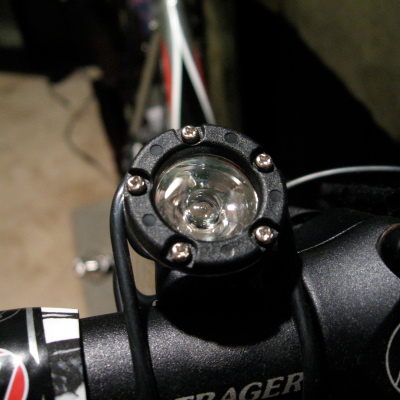
I picked this item up as a weekend special ($70 discount) from DiNotte. The catch? No rechargeable batteries, no battery charger, and no helmet mount kit were included. I didn't need any of those, so it was worth the savings. Even so, at about $170 with all the above stuff included, this is a great lighting solution for the money.
Package Contents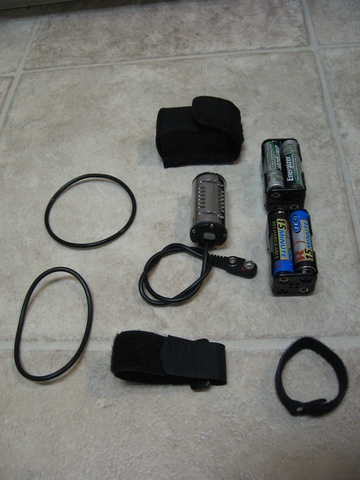
* DiNotte 200 Lumen LED light engine
* Battery clips (batteries not included with my purchase) (2)
* O-Rings (2)
* Velcro straps (2)
* Canvas battery pocket
* Basic instruction sheet (in the trash by now, I don't believe in instructions)
Mounting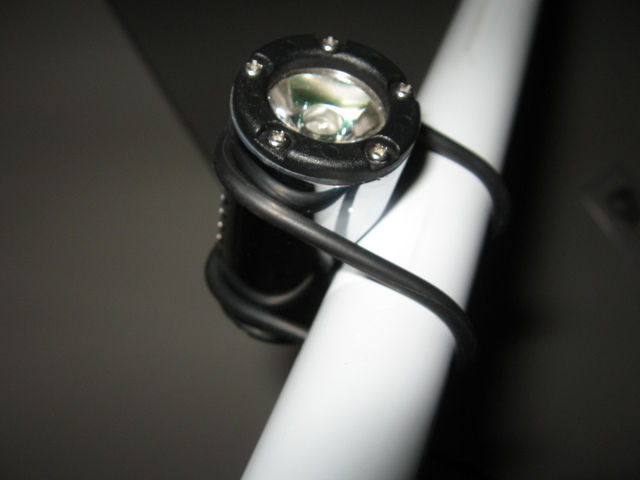
The DiNotte has a unique mounting system that's elegant in its simplicity. Just slip the o-ring around the handlebar (or seatpost for the tail light) and snap it into the groove on the top of the light engine. The o-ring provides holding power that's more reliable than awkward clips or clamps, and a small rubber pad on the underside of the light engine grips the handlebar to keep the light pointed where you aim it.
I was also able to easily mount it to my helmet without any special mounting hardware, but that was only due to the shape and placement of the vents on my Bell Solar: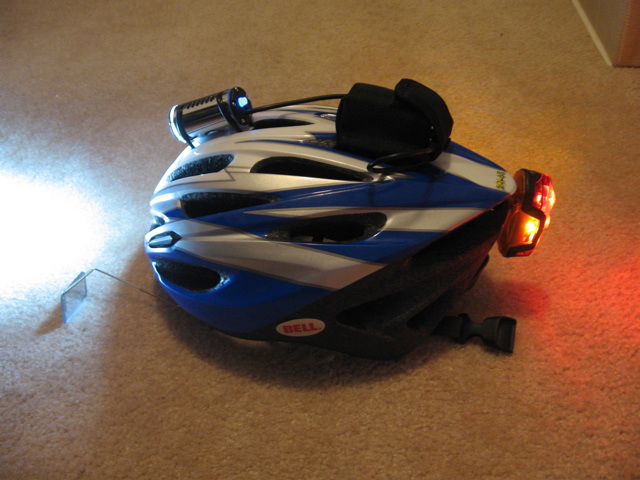
Using the light
Since I threw out the instructions right from the get-go, it took me about 30 seconds to figure out how this thing works. That's okay, because the instructions would have taken me a minute or two to read.
- Double-click the button to engage the light.
- Hold the button for two seconds to turn the light off.
- Press the button to change brightness (steady mode) or pattern (flash mode).
- Hold the button for six seconds to change between steady and flash mode.
There's a light in the button which normally glows blue. It blinks at different speeds to communicate what brightness level or flash pattern is in use. When the battery pack gets low, the button's back-light will switch to red and the LED will momentarily strobe quickly. After a few minutes of warning, the light system will fail to low brightness mode and the red switch will flash. With healthy (but depleted) rechargeable batteries, this "limp home" mode can last quite a while, but the LED will eventually dim and fade out. On a totally dark road or bicycle path, you will want to ride slowly and cautiously if the light switches to reserve power.
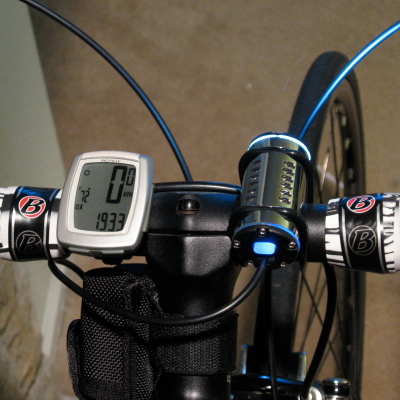
Run time
I started hunting for another light setup when I realized that 90 minutes of run-time from my halogen rig wasn't going to cut it. I'd say that the DiNotte's run-time for the amount of light it offers was the biggest selling point for me. Although it might only be a few times per month, there are occasions where I may be riding in the dark for 3-4 hours in a single day.
From a set of 2000mA NiMH Rechargeable AA cells, expect about 3 hours of use at full brightness, 4-8 hours on the medium steady and blinking modes, and an astonishing 12 hours or so (not tested) if using only the low light mode.
The LED element in the DiNotte 200L draws some serious current. Inexpensive LED lights claim run-times as long as 20 hours on four AA batteries, so 3 hours is quite a drain. Those amps have to go somewhere, and inevitably, there's quite a bit of heat being created to go with the light. The light engine's casing acts as a heat sink for the LED. Indeed, the case gets hot if left on without airflow around it. That pattern in the metal isn't just for looks -- it's a radiator!
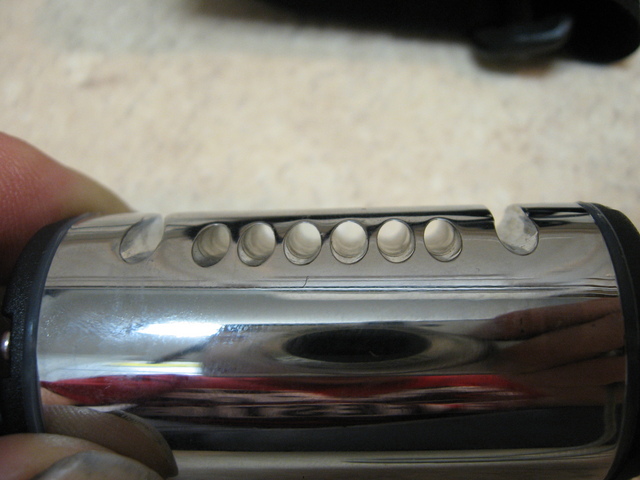
Light output and comparison
When I was on some of the longer night-time rides, I was forced to use my old Blackburn Quadrant as my only source of light. It works fine as a "to be seen" light, but does little to warn of obstacles in the path before you. The DiNotte is the answer to my problem of having enough light to see with while not compromising run time.
I'd say that the light output of the DiNotte 200L on its highest setting is about equal to my NiteRider with the original 10W bulb (which burned out with about 3 months of daily use) To compare my NiteRider Evolution 10W side by side with the Dinotte:

Since the halogen bulb burned out in my NiteRider, I switched to an aftermarket 15 watt bulb which reduced run time by almost an hour. The modified NiteRider is considerably brighter, with a much tighter spot light effect, but a broader flood than the DiNotte. If seeing down the road at all costs is the objective, the 15W halogen bulb wins. The DiNotte beam is on the left, 15W Halogen is on the right.
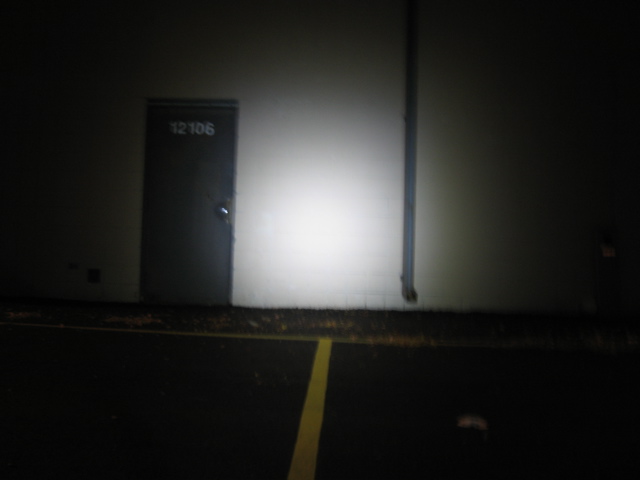
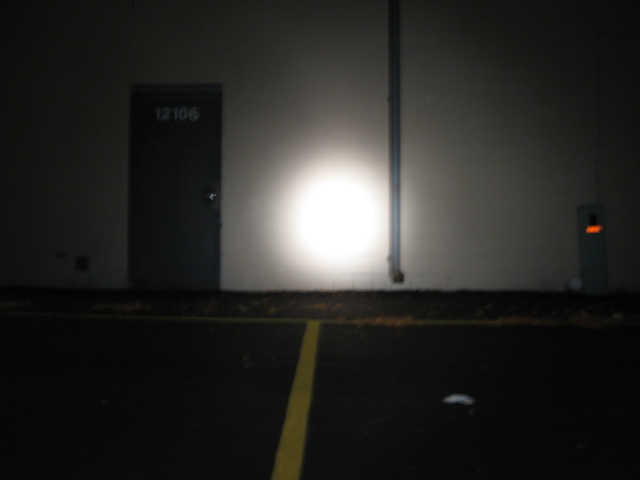
If you run the two at the same time, you essentially have broad daylight at your disposal:
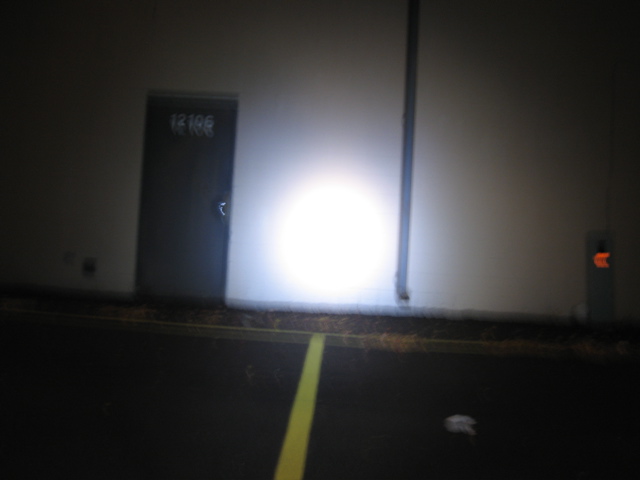
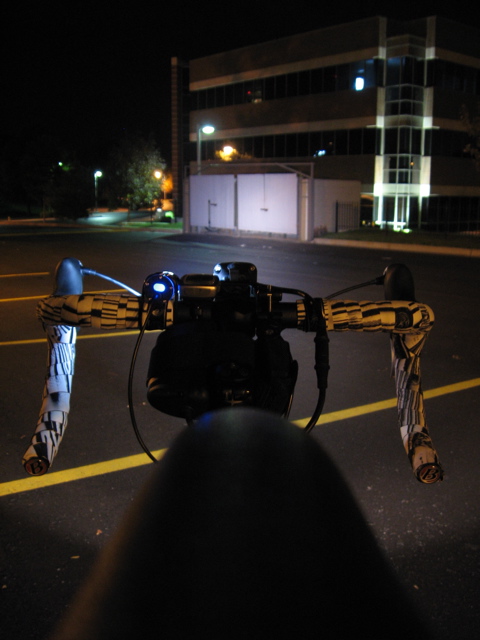
During the morning and evening twilight hours, the DiNotte's strobing patterns are extremely vivid and hard to ignore. I would almost call it annoying. Reflective street signs blink back at me, even with the sun in the sky. Now, even during the day, I don't commute without the DiNotte flashing away.
LED lighting has come a long way in the last few years. It used to be that LED lights were only "okay" to be seen by. The new advances in LED technology have brought us to a point where a lot of usable light and some good run-time can be squeezed from LED-based solutions.
Overall, I think that halogens still have a solid hold on the title of "best bang for the buck" simply because halogen setups are so inexpensive. They can be over-volted, bulbs are cheap and require no extra circuitry, but the only way to get a long burn out of halogen is to carry around a bulky battery pack. The more light you want, the more batteries you'll have to carry.
With the DiNotte, I can have the batteries hooked up to the light, then carry one spare battery clip full of freshly-charged cells in a pocket somewhere, and get 6 full hours of light that's on par with a 10W halogen setup. The cost is a little higher, but I think the payoff is worth it in the long run if you don't need more light than the 200L will put out.
The DiNotte 200L-AA-S kit (most similar to what I purchased) can be found here:
http://store.dinottelighting.com/Product2
It includes all that's shown above, plus 4 NiMH AA cells, a battery charger, and helmet mount kit. Retail price: $169.



7 comments:
Nice review. Thanks.
thanks for the review. with 4th of July traffic, i was persuaded to look for a better light than my little planet bike blaze and super spot.
i appreciate your blog. maybe we commuting bloggers can get some kind of commuting 'blog-ring going'?
Webrings are so 1996. Simply blogrolls are hotness 2.0. Add me to your blogroll in google reader (as I have already added yours to mine) then use blogger to share your google reader blogs and that's about as close as it gets ;)
Most of the images in your review don't load.
I just ordered two of these form dinotte, but I payed a lot more than you ($118 for the same thing you paid $75 for). I told myself that if I wait for a sale, I might get run over on my way home, and then what good would the extra $80 do me?
Nice, Thanks for the great review.
led holiday lights
How did you attach that mirror to your helmet? I have the same mirror and helmet but haven't found a good way to attach it.
On that helmet, I used the tab it came with. On my new helmet, I have a sun visor. I attached it to my visor and then locked it down with zip ties. I had a lot of trouble with that mounting tab that came with it. It didn't want to stick to my helmet foam.
Post a Comment